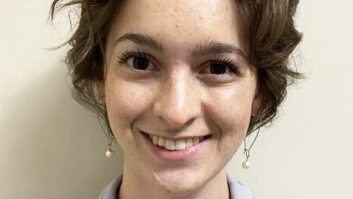Russound boosted the feature set, performance and multizone capabilities of multiroom-audio systems equipped with A-BUS technology, which delivers power and audio signal over a single CAT-5 cable to in-wall keypads incorporating built-in amplifiers.
In its latest A-BUS system, Russound became the first supplier to marry A-BUS with digital amplification to boost output the analog amps used in other A-BUS systems. A-BUS technology is licensed by its inventor, LeisureTech Electronics of Australia, to Russound and other companies, but only Russound to date has come up with a digital-amp variation of the core A-BUS technology, confirmed Scott Sylvester, VP of LeisureTech’s U.S. operations.
The Russound system is also Russound’s first A-BUS system with keypads that display source names on an LCD screen. Via optional keypad with source and transport controls, it will be among the industry’s first with transport controls in the keypad, Sylvester added. In the past, a handheld universal IR remote communicating with the IR receiver of an in-wall keypad was needed to perform those functions in an A-BUS system.
At least one other supplier plans an A-BUS system with transport controls in the keypad, but that system’s keypads will control only that suppliers’ source components, whereas the Russound system can be programmed to control multiple brands of source components, Sylvester noted.
In other enhancements, Russound expanded the capabilities of its latest A-BUS system to six sources and eight zones from four sources and four zones.
Russound’s latest A-BUS system retails for a suggested $2,599 with six single-gang keypads with IR receiver and LCD display, an IR remote, IR emitters and a system hub. An optional keypad with source-control and transport-control buttons is also available. All were to ship at the end of March.
The new Russound system “provides added performance and features like a more typical distributed-audio system,” Sylvester said. “We approved this system months ago while it was in development. It still offers the simplicity of A-BUS system design — one amplifier per location — and excellent energy efficiency.”
Enhancements are coming to A-BUS systems, Sylvester continued, in part to respond “to the explosion of programmable control systems at lower price points near A-BUS pricing.” New technology such as improved digital amplification is another factor in the A-BUS evolution.
Class D amplification has evolved to solve past problems that it presented when suppliers tried to design them into A-BUS systems, Sylvester explained. The frequency response of a class D amplifier, for example, “varied dramatically depending on the length of the speaker wire,” whose length will vary from house to house and from room to room in different installations, he explained. And because of its RF emissions, suppliers had to shield it, causing the amp to heat up, he continued. Most types of digital amps had these problems in the past, he said, “and those without these problems had expense and size issues.”
LeisureTech has been studying the inclusion of digital amplifiers in A-BUS’ basic design “for quite a while but to date has not chosen to move from analog amps to digital amps”in the systems that it makes on an OEM basis for select licensees, Sylvester added.
The Russound system’s rack-mountable A-C68 hub, or controller, enables remote selection of up to six audio sources from eight independent zones and includes paging inputs, a 12-volt trigger and RJ-45 daisy-chaining of up to six hubs to create a 48-zone system. The hub also features a library of built-in IR codes to control other-brand source components. The hub also learns IR codes not in its library and features an embedded power supply, replacing the wall-wart power supply used in Russound’s previous A-BUS systems.
The included six single-gang A-K5L keypad/amplifiers are the company’s first A-BUS keypads with LCD display, which can be programmed to display source names up to five characters and features a 20-segment visual volume indicator. The keypad’s four buttons control on/off, source selection, volume, bass, treble, balance, loudness and such special functions as party mode. An IR passthrough allows for source and transport control via an included IR remote.
For the system, Russound also offers optional single-gang A-KSC keypad with source- and transport-control buttons, including track selection and pause. Common transport- and source-control symbols on 10 of the keys can be switched to numeric keys by pressing the 11th button.













